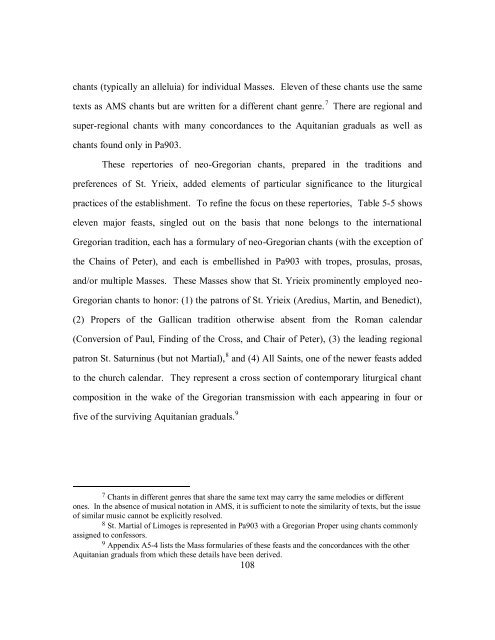Front Matter Template - The University of Texas at Austin
Front Matter Template - The University of Texas at Austin
Front Matter Template - The University of Texas at Austin
You also want an ePaper? Increase the reach of your titles
YUMPU automatically turns print PDFs into web optimized ePapers that Google loves.
chants (typically an alleluia) for individual Masses. Eleven <strong>of</strong> these chants use the same<br />
texts as AMS chants but are written for a different chant genre. 7 <strong>The</strong>re are regional and<br />
super-regional chants with many concordances to the Aquitanian graduals as well as<br />
chants found only in Pa903.<br />
<strong>The</strong>se repertories <strong>of</strong> neo-Gregorian chants, prepared in the traditions and<br />
preferences <strong>of</strong> St. Yrieix, added elements <strong>of</strong> particular significance to the liturgical<br />
practices <strong>of</strong> the establishment. To refine the focus on these repertories, Table 5-5 shows<br />
eleven major feasts, singled out on the basis th<strong>at</strong> none belongs to the intern<strong>at</strong>ional<br />
Gregorian tradition, each has a formulary <strong>of</strong> neo-Gregorian chants (with the exception <strong>of</strong><br />
the Chains <strong>of</strong> Peter), and each is embellished in Pa903 with tropes, prosulas, prosas,<br />
and/or multiple Masses. <strong>The</strong>se Masses show th<strong>at</strong> St. Yrieix prominently employed neo-<br />
Gregorian chants to honor: (1) the p<strong>at</strong>rons <strong>of</strong> St. Yrieix (Aredius, Martin, and Benedict),<br />
(2) Propers <strong>of</strong> the Gallican tradition otherwise absent from the Roman calendar<br />
(Conversion <strong>of</strong> Paul, Finding <strong>of</strong> the Cross, and Chair <strong>of</strong> Peter), (3) the leading regional<br />
p<strong>at</strong>ron St. S<strong>at</strong>urninus (but not Martial), 8 and (4) All Saints, one <strong>of</strong> the newer feasts added<br />
to the church calendar. <strong>The</strong>y represent a cross section <strong>of</strong> contemporary liturgical chant<br />
composition in the wake <strong>of</strong> the Gregorian transmission with each appearing in four or<br />
five <strong>of</strong> the surviving Aquitanian graduals. 9<br />
7 Chants in different genres th<strong>at</strong> share the same text may carry the same melodies or different<br />
ones. In the absence <strong>of</strong> musical not<strong>at</strong>ion in AMS, it is sufficient to note the similarity <strong>of</strong> texts, but the issue<br />
<strong>of</strong> similar music cannot be explicitly resolved.<br />
8 St. Martial <strong>of</strong> Limoges is represented in Pa903 with a Gregorian Proper using chants commonly<br />
assigned to confessors.<br />
9 Appendix A5-4 lists the Mass formularies <strong>of</strong> these feasts and the concordances with the other<br />
Aquitanian graduals from which these details have been derived.<br />
108

















